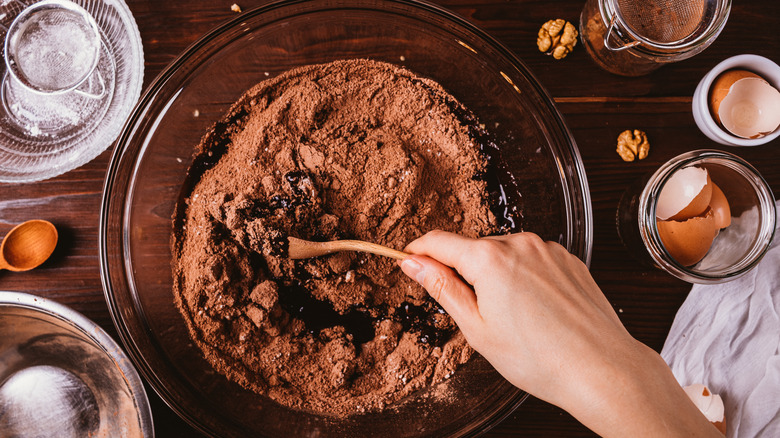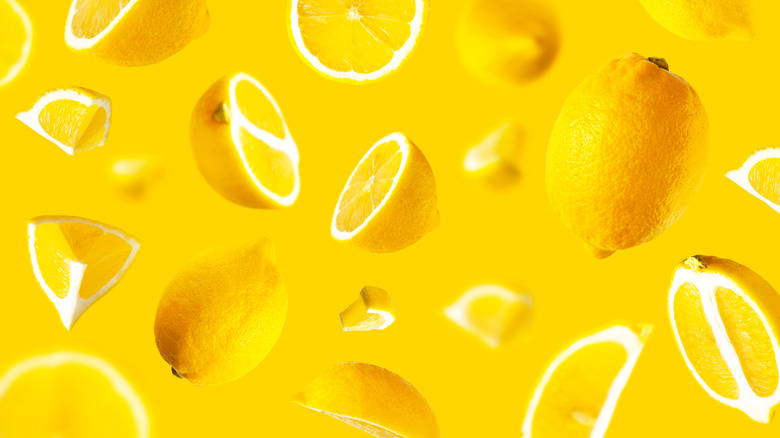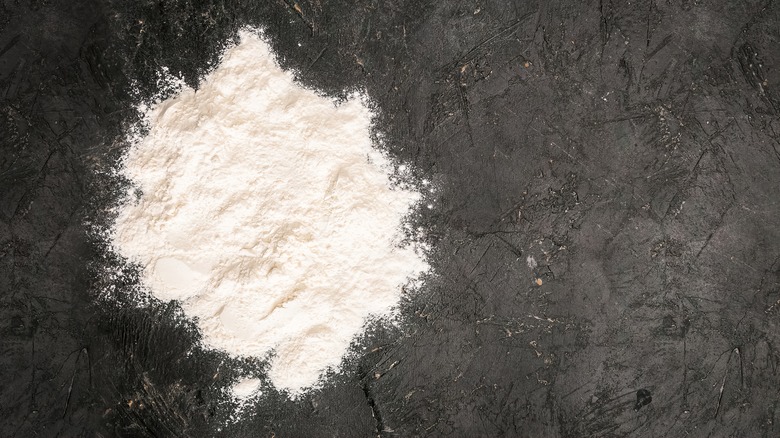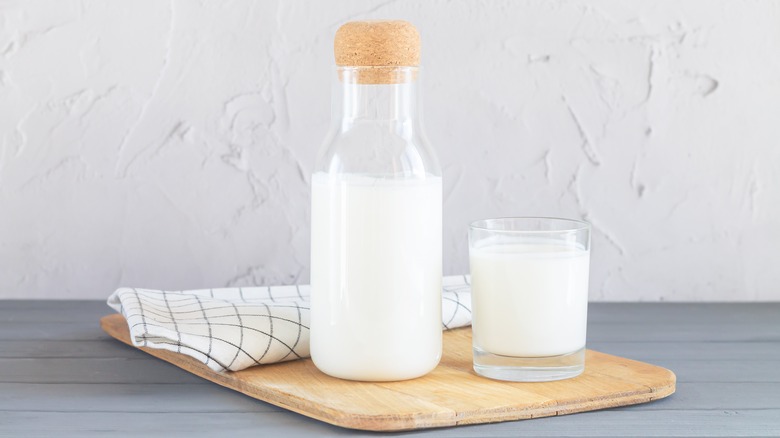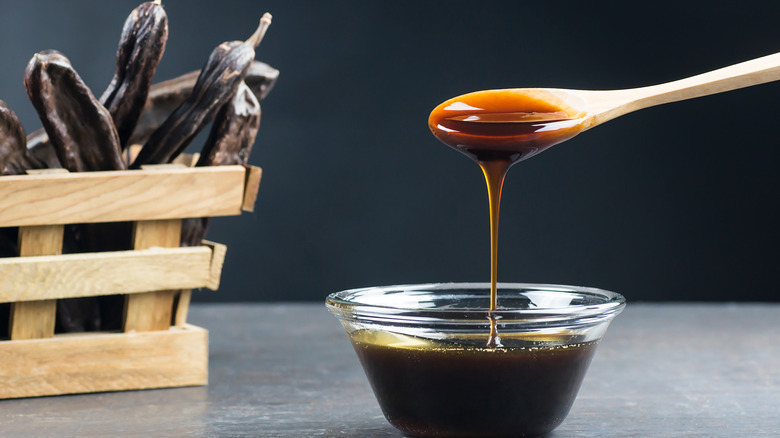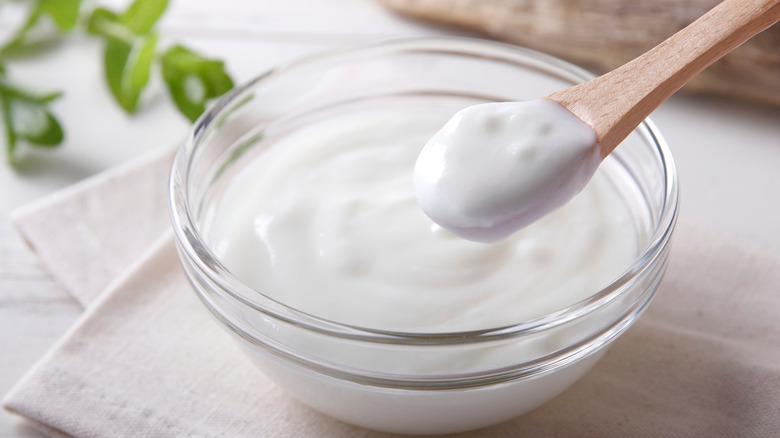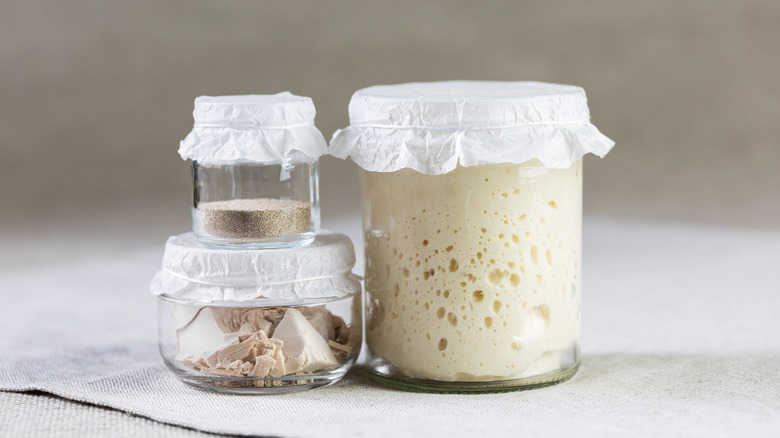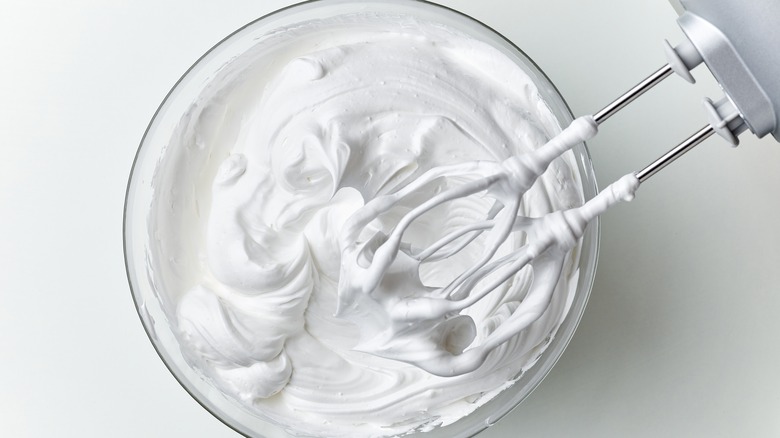The Absolute Best Baking Powder Substitutes
Baking powder is one of the most essential ingredients a household baker can have. According to KitchenAid, baking powder is considered a leavener — this means it interacts with acid, heat, and liquid to emit gas. This gas causes the food to rise and optimizes the crumb structure, volume, and texture of the finished product. Other examples of leaveners used in baking include natural leaveners like yeast and chemical leaveners like baking soda and baking ammonia.
Baking powder is made of two primary components: a carbonate base and a weak acid. The weak acid in commercial baking is typically cream of tartar (this is what gives snickerdoodle cookies their iconic tang). When the acid interacts with the bicarbonate, the reaction emits carbon dioxide gas. This gas is an essential part of the rising and baking process for many baked goods including cookies, cakes, and muffins.
But what happens when you run out of baking powder mid-way through a recipe? Here are some of the absolute best substitutes for baking powder that you can try in a pinch.
Cream of tartar
Cream of tartar is a common component of industrial baking powder. McGill University notes that cream of tartar is a byproduct of wine production. The powder is left as a residue after fermentation. From a baking perspective, cream of tartar is integral in slowing the formation of proteins to bond with one another. Without cream of tartar, the reaction would create lumps and render even the best-tasting meringue a flop. To counteract deflation and lumpiness, California pastry chef Alice Medrich suggests adding ¼ tablespoon of cream of tartar per four egg whites to recipes — regardless if the recipe specifies it or not.
Cream of tartar can be used in tandem with baking soda to replace baking powder. Substitute Cooking recommends a 2-to-1 ratio of cream of tartar to baking soda. This means if a recipe calls for 1 tablespoon of baking powder, use ⅔ tablespoon cream of tartar to ⅓ tablespoon baking soda.
Vinegar or lemon juice and baking soda
An acid like lemon juice or vinegar interacts with a bicarbonate like baking soda to produce carbon dioxide. This reaction provides enough rise in a baked good to replace baking powder. To substitute 1 tablespoon of baking powder, add ¼ tablespoon of baking soda and ½ tablespoon of vinegar or lemon juice.
Like cream of tartar, vinegar is a byproduct of fermentation. According to an article about the differences between vinegar, distilled white vinegar has a more neutral taste than other types of vinegar, like apple cider vinegar or rice vinegar. This flavor profile, along with its low pH level, makes vinegar an ideal substitute for baking powder in a recipe.
Lemon juice can also be used if distilled white vinegar is not available. Since the lemon juice in this recipe is being used as a leavener rather than a flavor component, using bottled juice over freshly squeezed juice is acceptable. Fresh lemon juice is preferable for a recipe where lemon is a key flavor, though, such as a lemon poppyseed cake.
Club soda
Club soda is seltzer's ugly cousin. According to Vinepair, club soda is a carbonated beverage containing minerals like sodium bicarbonate, sodium citrate, disodium phosphate, and sometimes sodium chloride. These minerals give club soda its distinctive flavor. Seltzer water is carbonated through the same process but does not contain trace minerals. Tonic water is carbonated, contains quinine, and is typically infused with a sweetener.
The purpose of the minerals in club soda are to neutralize acidity and mimic the flavors of club soda's un-carbonated cousin: mineral water. Renée Gan, a food scientist working with the TODAY Show, recommends working quickly when substituting club soda into any recipe because the carbon dioxide in the club soda escapes into the air and leaves the batter stodgy. When working with club soda, the baker must also diminish the proportion of wet ingredients so the batter is not too wet when the club soda is added.
Self-rising flour
As its name implies, self-rising flour is traditional wheat flour that contains a leavening agent. Historically, self-rising flour was used by English sailors to bake fluffy, risen bread on board without having to concoct a mixture of flour and leaveners while underway. King Arthur Baking Company says that the flour is typically mixed with baking powder and salt. Self-rising flour appears frequently in Southern dishes like biscuits and cornbread muffins.
Self-rising flour is useful to the baker without access to baking soda or baking powder. Simply substitute for all-purpose flour in equal amounts and omit additional the baking soda called for in the recipe. If you want to make your own self-rising flour at home for future use, Bob's Red Mill recommends combining 1 cup of all-purpose flour, 1½ teaspoon baking powder, and ¼ teaspoon fine salt. This flour will keep in a dark, dry space for months at a time.
There are some occasions where self-rising flour is not an appropriate substitution for baking powder, such as yeast-leavened bread and sourdoughs.
Buttermilk
Buttermilk is the thin liquid left over from churning butter. When the buttermilk sits at a warm temperature, it develops a whole host of probiotic bacteria that aid in the digestive process. Modern commercial buttermilk is produced by inoculating pasteurized milk with lactic acid bacteria. Home cooks can make their own buttermilk by combining 1 cup of milk and 1 tablespoon vinegar or lemon juice and resting the mixture for five to 10 minutes, as recommended by Cookie and Katie.
Buttermilk is a substitution for baking powder because of the chemical reaction that occurs post-fermentation. As the bacteria multiply, a new byproduct is produced: lactic acid. The acidity of the buttermilk interacts with alkaline baking soda to produce a rise in the batter or dough. The rest of the recipe may need to be adjusted to diminish the amount of liquid in the batter if using buttermilk as a substitute for baking powder.
Molasses
Molasses is a sweet syrup used in cooking and baking. Its the byproduct of sugar-making and is traditionally derived from sugarcane or sugarbeets. Light and dark molasses, which are two of the most common types of molasses used in baking, have about a 70% sugar content. Blackstrap molasses has a comparatively low sugar content, but it tends to overpower the taste of the baked goods it's used in.
According to Utah State University, molasses can be utilized in place of baking powder because of its acidic qualities; they recommend mixing ¼ cup of molasses with ¼ teaspoon of baking soda to replace 1 teaspoon of baking powder. Like other liquid substitutions, the number of other ingredients may have to change to avoid making the batter too wet. Additionally, a baker may have to cut back on sugar, honey, maple syrup, or other sweeteners to accommodate the taste and sweetness of molasses in a recipe.
Plain yogurt
Plain yogurt is a source of calcium and probiotic bacteria. It is also a versatile substitute in baking because of its acidity and creaminess. Yogurt can add a layer of moisture to baked goods, such as Sally's Baking Addiction's Lemon Berry Yogurt Cake or your favorite muffin recipe.
Substitute yogurt for baking powder by using ½ cup of plain yogurt with ¼ teaspoon of baking soda for the rising power of 1 teaspoon of baking powder. It is important to choose a yogurt without flavoring. Greek yogurt can be used in place of plain yogurt, as long as the baker adjusts other liquids in the recipe to accommodate the increased moisture. Elapasony recommends a coconut milk yogurt substitute (along with some lemon juice) for plant-based baking over other plant-based yogurt varieties because of its fattiness and creaminess. However, it is not clear if there is a difference between plant-based and dairy yogurt substitutes for baking powder.
Yeast
"Yeast" is the broad-stroke term for the microbial life that gives rise to bread. According to Red Star Yeast, yeast microbes digest sugar molecules for growth, which in turn release carbon dioxide and ethyl alcohol during fermentation. The ethyl alcohol is what bakers smell in the air when the bread is rising. The carbon dioxide provides the bubbles that give yeast its rise.
Baking powder and yeast are not always interchangeable in recipes because they have different rising capabilities, Livestrong notes. Baking powder should not be used as a substitute for yeast in kneaded bread because it will not replicate the same effect, nor will it produce the delicious smell of freshly risen bread. The Whole Portion does not recommend using yeast as a substitute for baking powder, either, as it will change the taste, flavor, texture, and density of the following product. Moreover, it is recommended that bakers choose another one of the substitutes listed instead of yeast. However, if you think it'll work as a substitute in your recipe, we say to try it out.
Beaten egg whites
Whipped egg whites can provide a comprehensive structure to baked goods. Whipping the whites creates tiny air pockets. This method is used for a variety of baked goods including fluffy soufflés and buttery, soft pancakes. The amount of eggs used as a baking powder substitute depends on the recipe. Dense cakes will require more egg whites than light pancakes or waffles.
To prepare the egg whites, whip the egg whites with a hand-held beater until they are foamy (this should take about two minutes) and slowly increase the speed until stiff peaks are formed (as seen in the picture above). A stand mixer with a whisk attachment can also be used. When adding the whipped egg whites back into the batter, be sure to avoid over-mixing. Over mixing will beat the air out of the egg whites, rendering them useless in promoting a proper rise (the whole reason you're doing this).
Skip the leavener altogether
Leavening agents are an integral part of baking a well-risen and well-textured baked good. While a baker can omit a leavener like baking powder from cookie dough and still bake a cookie, the resulting cookie will be dense and hard rather than soft and pillowy.
The only thing more important than making sure baking powder is present in a recipe is making sure the baking powder is still "good." According to Utah State University, baking powder typically lasts between a year and six months to two years. However, the ingredients in baking powder are sensitive to moisture and humidity, so the baking powder can expire quickly if it is kept in a damp cabinet. Moreover, a baker can test if baking powder is still good by adding ½ teaspoon of baking powder to ¼ cup of boiling water. If the mixture bubbles, the can is still good! If the baking powder falls flat, throw the can in the trash and try one of the substitutes listed above.

